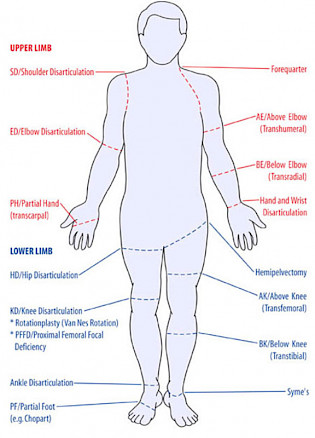As you may know there is a long list of possible amputations someone could have. Here we are going to briefly look at the 15 listed in the chart below.
Upper Body
Shoulder Disarticulation (SD) – The most common reason for this specific amputation is a tumor or a tragic accident where the arm is severed and cannot be saved. As you can see from the chart, this is where the entire arm (at the shoulder joint) is removed. Surprisingly, there are no bones cut during this surgery.
Elbow Disarticulation (ED) – The advantage of an elbow disarticulation is that it allows anatomic suspension, more control of the prosthesis and reduces rotation of the socket of the residual limb. The leading cause of this type of amputation in adults is trauma. In children, the leading cause is tumors.
Partial Hand – this can be anything from 1 finger to 5 fingers or an amputation through the palm. For the most part these are caused by some type of accident but can also be from disease, frostbite or patients can be born with missing fingers or parts of their hands. Any part of the hand being amputated accounts for about 90% of all upper body amputations.
Forequarter – Forequarter amputations are becoming less common but when this particular surgery is performed as an attempt to remove cancer from the body. With this amputation, they take the arm, scapula and clavicle.
Above Elbow (Transhumeral) – This amputation separates the lower arm from the upper arm at the elbow joint. The lower bone arms are separated from the humerus. No bones are cut during this surgery.
Below Elbow (Transradial) – This is where the lower part of the arm is removed. This leaves the elbow intact and makes for an easier recovery. It is most likely that you will be able to use your residual limb as most of the arm is unharmed.
Hand and Wrist Disarticulation – With accidents being the leading cause of upper body amputations, depending on where the injury is will depend where the amputation will take place on the hand and/or wrist. The goal is always to keep as much of the limb as possible.
LOWER BODY
Hip Disarticulation (HD) – This procedure is less common since the 1970s, when it is performed it is to take out any tumors in the upper leg. Now, with new technology often more of the leg can be saved. With the many developments of prosthetics people who have had this surgery can often be fully functional with physiotherapy and guidance from a prothethesis.
Knee Disarticulation (KD) – This can also be known as through-knee amputation, it is where the amputation happens right at the knee joint as opposed to the femur. This procedure is often recommended for children to help preserve their growth plate at the end of their thigh. KD only accounts for about 2% of major limb loss surgeries.
Ankle Disarticulation (AD) – This procedure is performed by removing the foot between the ankle bones to avoid cutting through a bone. This procedure is performed most often in adults.
Partial Foot (PF) – This procedure is most often performed with patients who have diabetes. Other common reasons for this procedure is frostbite, and cancerous tumors. Recovery time for this procedure can be relatively quick but extreme caution must be taken to avoid infection.
Hemipelvectomy – This procedure is mostly commonly performed to treat pelvic malignancies (pelvic tumor). It involves taking the entire leg and usually includes taking the hemipelvis. In recent years, there have been developments that include doing an internal hemipelvectomy which may save the limb if it is functional.
Above Knee (Transfemoral) – This amputation is performed to remove the lower limb at or above the knee joint. It will likely occur for the following reason; trauma, disease or congenital defect.
Below Knee (Transtibial) – A below knee amputation occurs when the lower limb below the knee joint is removed. Approximately 60% - 70% of below knee amputations occurs because of disease of the circulation in the lower limb.
Syme – With a Syme amputation the foot is removed but the heel pad is left in hopes that the patient will be able to use the leg without a prosthetic. The amputation is done through the ankle joint. The goal of this procedure is to get rid of the diseased or painful part of the foot and make it more functional and less painful.
If you know that you are facing an amputation it can be overwhelming, this is a place to start. We are always happy to answer any other questions you may have. You can contact us to schedule your free pre-surgery consultation by calling 1-800-661-8777 or by emailing info@winpo.ca.

RESOURCES
http://www.oandplibrary.org/alp/chap10-01.asp
https://www.armdynamics.com/our-care/amputation-levels
https://www.amputee-coalition.org/leg-amputation-guide/
https://academic.oup.com/ptj/article/88/8/916/2683575
https://www.footcaremd.org/conditions-treatments/injections-and-other-treatments/syme-amputation
